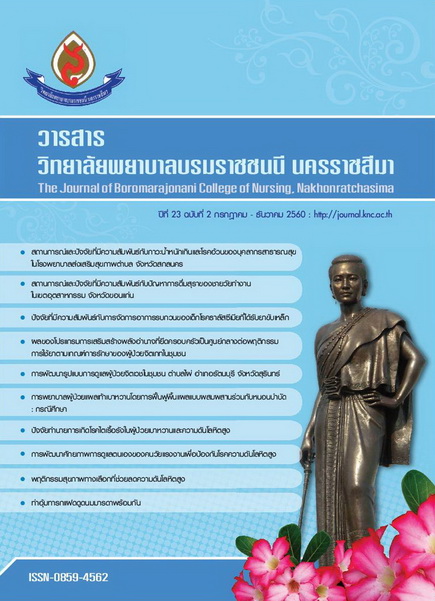ปัจจัยที่มีความสัมพันธ์กับการจัดการอาการรบกวนของเด็กโรคธาลัสซีเมียที่ได้รับยาขับเหล็ก
คำสำคัญ:
การจัดการอาการ, อาการรบกวน, เด็กโรคธาลัสซีเมีย, ยาขับเหล็ก, Symptom Management, Discomport Symptom, Children with Thalassemia, Iron Chelationบทคัดย่อ
บทคัดย่อ
เด็กโรคธาลัสซีเมียต้องเผชิญกับภาวะสุขภาพและอาการรบกวนจากการรักษาด้วยยาขับเหล็ก ซึ่งการจัดการกับอาการที่มีประสิทธิภาพจะทำให้อาการนั้นทุเลาลงหรือไม่เกิดอาการ และคุณภาพชีวิตดีขึ้น การวิจัยแบบพรรณนาเชิงหาความสัมพันธ์ครั้งนี้ มีวัตถุประสงค์เพื่อศึกษาความสัมพันธ์ระหว่าง อายุ ความรู้ในการดูแลตนเอง การรับรู้อาการรบกวน และการสนับสนุนทางสังคม กับการจัดการอาการรบกวนของเด็กโรคธาลัสซีเมียที่ได้รับยาขับเหล็ก กลุ่มตัวอย่าง คือ เด็กวัยรุ่นโรคธาลัสซีเมียชนิด β Thalassemia/ Hb E disease และ β Thalassemia major ที่ได้รับยาขับเหล็ก Deferiprone มาแล้วอย่างน้อย 6 เดือน และเข้ารับการรักษาต่อเนื่องที่โรงพยาบาลสรรพสิทธิประสงค์ จังหวัดอุบลราชธานี อายุระหว่าง 10-19 ปี จำนวนทั้งหมด 100 ราย คัดเลือกกลุ่มตัวอย่างโดยการสุ่มอย่างง่าย เครื่องมือที่ใช้ในการเก็บรวบรวมข้อมูลประกอบด้วย แบบสอบถามความรู้ในการดูแลตนเอง แบบสอบถามการรับรู้อาการรบกวน แบบสอบถามการจัดการกับอาการรบกวน และแบบสอบถามการสนับสนุนทางสังคม มีค่าความเชื่อมั่นเท่ากับ .83 .74 .87 และ .92 ตามลำดับ วิเคราะห์ข้อมูลโดยการหาค่าความถี่ ร้อยละ ค่าเฉลี่ย ส่วนเบี่ยงเบนมาตรฐาน พิสัย และค่าสัมประสิทธิ์สหสัมพันธ์ของเพียร์สัน
ผลการวิจัย พบว่า อายุ (r = .402, p < .001) ความรู้ในการดูแลตนเอง (r = .424, p < .001) การรับรู้อาการรบกวน (r = .343, p < .001) และการสนับสนุนทางสังคม (r = .354, p < .001) มีความสัมพันธ์ทางบวกในระดับปานกลางกับการจัดการอาการรบกวนของเด็กโรคธาลัสซีเมียที่ได้รับยาขับเหล็กอย่างมีนัยสำคัญทางสถิติ (p < .001)
จากผลการศึกษาครั้งนี้เสนอแนะว่า พยาบาลควรประเมินและวางแผนการพยาบาลเพื่อจัดการกับอาการรบกวนสำหรับเด็กโรคธาลัสซีเมียที่ได้รับยาขับเหล็กให้มีประสิทธิภาพ โดยให้ความรู้ในการดูแลตนเอง เพิ่มการรับรู้อาการรบกวน และการสนับสนุนทางสังคม
คำสำคัญ: การจัดการอาการ, อาการรบกวน, เด็กโรคธาลัสซีเมีย, ยาขับเหล็ก
Factors Related to Discomfort Symptom Management of Thalassemia Children Treated by Iron Chelation
Abstract
Children with Thalassemia need to cope with health conditions and discomfort symptoms from iron chelation therapy. Effective symptom management could prevent and/or reduce discomfort symptoms which will lead to a better quality of life. This descriptive correlational study aimed to examine the relationships between age, knowledge of self-care, perception of discomfort symptoms, social support and discomfort symptom management among children with Thalassemia who received iron chelating therapy. A random sample of 100 children with β Thalassemia/ Hb E disease and β Thalassemia major who have received iron-chelator (Deferiprone) for at least 6 months, aged between 10-19 years at Sunpasitthiprasong Hospital, Ubonratchathani province, was selected in the study. The Knowledge of Self-Care Questionnaire, the Perception of Discomfort Symptom Questionnaire, the Social Support Questionnaire and the Discomfort Symptom Management Questionnaires were used to collect data. The reliabilities of questionnaires were .83, .74, .87, and .92 respectively. Data were analyzed by using frequency, percent, mean, standard deviation, range and Pearson’s product moment correlation coefficient.
The results showed that age (r = .402, p < .001), knowledge of self-care (r = .424, p < .001), perception of discomfort symptoms (r = .343, p < .001) and social support (r = .354, p < .001) were significantly positively related to discomfort symptom management.
These findings suggest that nurses should assess and provide interventions to enhance discomfort symptom management for Thalassemia children treated by iron chelation by providing knowledge of self-care, increasing perception of discomfort symptoms and social support.
Keywords: Symptom Management, Discomport Symptom, Children with Thalassemia, Iron Chelation
ดาวน์โหลด
เผยแพร่แล้ว
ฉบับ
ประเภทบทความ
สัญญาอนุญาต
บทความที่ได้รับการตีพิมพ์เป็นลิขสิทธิ์ของ วารสารสุขภาพและการศึกษาพยาบาล ซึ่งดำเนินการโดยวิทยาลัยพยาบาลบรมราชชนนี นครราชสีมา
ข้อความที่ปรากฏในบทความในวารสารเล่มนี้เป็นความคิดเห็นส่วนตัวของผู้เขียนแต่ละท่านไม่เกี่ยวข้องกับกองบรรณาธิการวารสารสุขภาพและการศึกษาพยาบาล หรือวิทยาลัยพยาบาลบรมราชชนนี นครราชสีมา แต่อย่างใด ความรับผิดชอบองค์ประกอบทั้งหมดของบทความแต่ละเรื่องเป็นของผู้เขียนแต่ละท่าน หากมีความผิดพลาดใดๆ ผู้เขียนแต่ละท่านจะรับผิดชอบบทความของตนเองแต่ผู้เดียว







